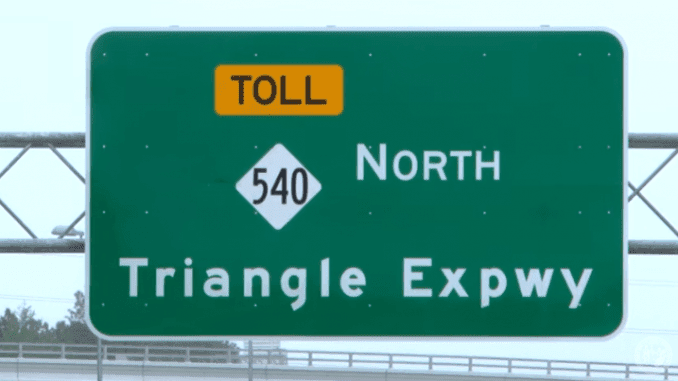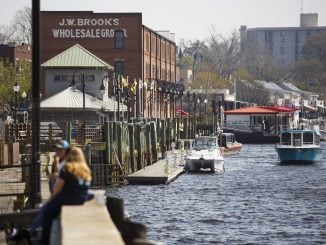
RALEIGH — Environmental groups agreed to a $45 million legal settlement that clears the way to finish the Raleigh Outer Loop, but not before muscling state transportation officials into a pair of statewide climate change programs.
“The current project schedule, which is subject to change, would have construction beginning as early as late this year,” said N.C. Turnpike Authority spokeswoman Carly Olexik.
Sound Rivers, Inc., the Center for Biological Diversity, and Clean Air Carolina, all represented by the Southern Environmental Law Center, dismissed their claims in exchange for a variety of mitigation and protective measures for several species of aquatic wildlife in the path of the N.C. Turnpike Authority’s $2.2 billion Triangle Expressway Southeast Extension. But other strings are attached.
The N.C. Department of Transportation will collect and monitor information on how many miles all of North Carolina’s motorists travel each year, starting in three months. The data will be used to develop strategies to cut back on driving. Olexik said transportation officials agreed to that stipulation to allow the project to move forward.
It’s unclear how transportation officials will collect drivers’ data, and how it might be used.
The legal settlement requires hiring a firm within nine months to study ways to reduce driving, with a report due one year after hiring. A task force would be created to develop “a tool kit [that] will include information regarding what actions are possible at what levels of government, what funding is available, and similar information.”
The settlement also mandates that DOT and its highway construction contractors increasingly use more expensive heavy equipment with advanced control technologies to reduce greenhouse gas emissions.
Initially the requirement would be imposed only in Wake, Durham, Orange and Chatham counties for contracts involving at least $50 million and 1 million cubic yards of earth moving.
After 2023 it would be reviewed for statewide implementation.
At least 25 percent of equipment must meet Tier 4 diesel engine standards — the Environmental Protection Agency’s strictest emission requirements for off-highway diesel engines — in 2020.
That increases to 35 percent in 2021, and 50 percent in 2022. Incentives would be offered for exceeding the Tier 4 requirements. Alternatively, the settlement sets higher required percentages combining Tier 4 and older Tier 3 equipment.
Results will be analyzed to determine what percentages to set in 2023.
“These requirements are in line with EPA guidelines,” Olexik said. “We do not anticipate a negative effect on the number of bidders or bidding competition” due to the tougher rules.
“Yes, it will have impacts on the roadbuilding industry,” said Victor Barbour, spokesman for Carolinas AGC, a trade group representing road and transportation builders. “The impacts will be greater for companies with older fleets.”
The cost of adding new equipment could be a barrier to some companies qualifying for future
N.C. DOT projects, Barbour said. Since the requirements are on a graduated time frame, the association hopes the impact would be minimal.
Barbour wasn’t prepared to call the move anti-competitive regulation, “but it could be an unintended consequence.”
The legal settlement further requires N.C. DOT to join the Transportation and Climate Initiative, a clean energy collaboration of 12 states and the District of Columbia, as an observer.
The 540 Outer Loop, sometimes called the Complete 540 Project, will stretch from the N.C. 55 Bypass in Apex to U.S. 64/Interstate-495 in Knightdale. The highway would link Apex, Cary, Clayton, Garner, Fuquay-Varina, Holly Springs, and Raleigh.
The environmental groups filed claims in federal court in 2018 and with the N.C. Office of Administrative Hearings in 2019 to stop the highway project. They claimed it threatened several creatures listed or proposed as endangered or threatened under the Endangered Species Act.
“North Carolina’s waterways are home to an incredible storehouse of aquatic biodiversity that lives under the increasing threat of extinction due to expanding factory farms, development and logging,” said Perrin de Jong, a staff attorney for the Center for Biological Diversity. “This agreement enacts the first major steps in turning the tide for our state’s imperiled aquatic species, giving them a shot at survival and making way for the recovery of our unique native wildlife.”
“Being able to settle these lawsuits moves this critical project forward and saves taxpayers millions of dollars,” Transportation Secretary Jim Trogdon said. “In addition, the components of this agreement offer strong environmental protections along the project corridor.”
But a wild card remains in play.
The Center for Biological Diversity sued the U.S. Fish and Wildlife Service in federal court in April 2018 to compel a long-awaited decision on its 2010 petition to designate the Neuse River waterdog salamander as a threatened species, and the Carolina madtom catfish as endangered. It withdrew the claim after the agency proposed adding them to the Endangered Species List in May 2019.
By law a determination must be made on the proposal by May 2020. But a wrinkle developed during a public comment period that closed in July.
Sarah McRae, USFWS lead biologist for the two species, said field work by biologists found the Carolina madtom in habitat it didn’t previously occupy, and the waterdog salamander in habitat it historically occupied but wasn’t found during a survey two years ago.
Those findings require the process to be reopened, and another 30-day public comment period scheduled. There are no set time frames for that to happen, McRae said, and nothing to prevent the Center for Biological Diversity from taking legal action again if the deadline is missed.



